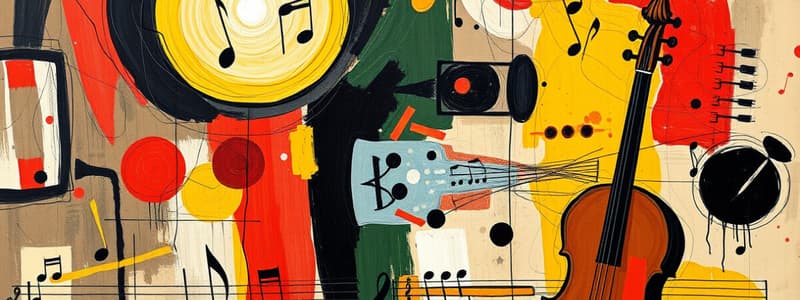Podcast
Questions and Answers
What is a primary characteristic of Expressionism?
What is a primary characteristic of Expressionism?
- Harmony based on classical structures
- Melody focusing primarily on consonant notes
- Polytonality featuring multiple keys (correct)
- Employment of traditional key centers
Which technique did Arnold Schoenberg develop?
Which technique did Arnold Schoenberg develop?
- Sonata form
- Counterpoint style
- 12-Tone Technique (correct)
- Fugue technique
Which of the following best describes the rhythms of Expressionism?
Which of the following best describes the rhythms of Expressionism?
- Strict adherence to simple meters
- Complex rhythms and polyrhythms (correct)
- Monorhythmic structures
- Regular and predictable rhythmic patterns
Which of the following compositions is NOT associated with Igor Stravinsky?
Which of the following compositions is NOT associated with Igor Stravinsky?
What distinguishes Expressionist music from other styles?
What distinguishes Expressionist music from other styles?
Expressionism in music is primarily a reaction to which artistic movement?
Expressionism in music is primarily a reaction to which artistic movement?
Flashcards are hidden until you start studying
Study Notes
Expressionism in Music
- Expressionism is a music style that highlights emotional intensity and mental disturbance, emerging as Germany's response to French Impressionism.
- It is more effectively performed with instruments rather than vocal parts.
Key Characteristics of Expressionism
- Atonality: Lacks a central key, creating a free-form musical experience.
- Complex Rhythms: Shifts from simple rhythmic patterns to intricate structures.
- Polyrhythm: Employs multiple conflicting rhythms occurring simultaneously.
- Polyharmony: Integrates dissonant harmonies, moving away from traditional key frameworks.
- Polytonality: Uses two or more keys at once, leading to dissonant harmonies.
Notable Expressionism Composers
-
Arnold Schoenberg (1874-1951):
- Developed the 12-Tone Technique, which organizes 12 chromatic pitches into a series that forms the core of melody and harmony.
- Started violin lessons at age 8 and studied counterpoint with Alexander von Zemlinsky, introducing him to Vienna's musical style.
- Recognized for works like "Transfigured Night" and techniques such as Inversion, Retrograde, and Retrograde Inversion.
-
Igor Stravinsky (1882-1971):
- Renowned Russian composer, pianist, and conductor influential in modern music circles.
- Pursued studies in law and philosophy at St. Petersburg University while coming from a musical family; his father was a bass singer at the Imperial Opera.
- Mentored in orchestration by Rimsky-Korsakov, a respected Russian composer who recognized Stravinsky's talent.
- Famous compositions include "The Rite of Spring," "Oedipus Rex," and "The Wedding."
Studying That Suits You
Use AI to generate personalized quizzes and flashcards to suit your learning preferences.




